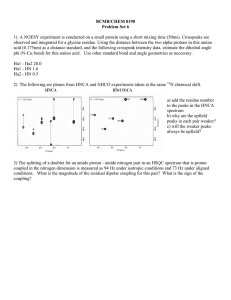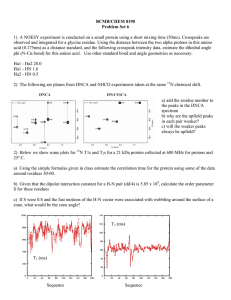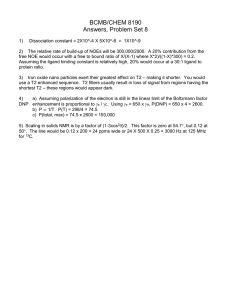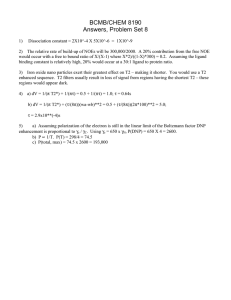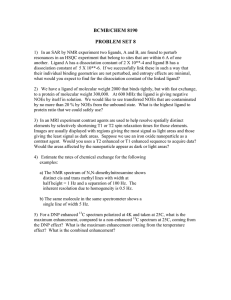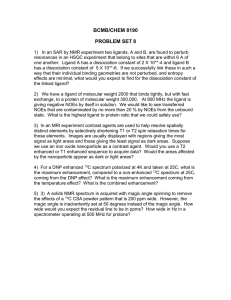Contents • Data processing • Experiment examples • Other software
advertisement
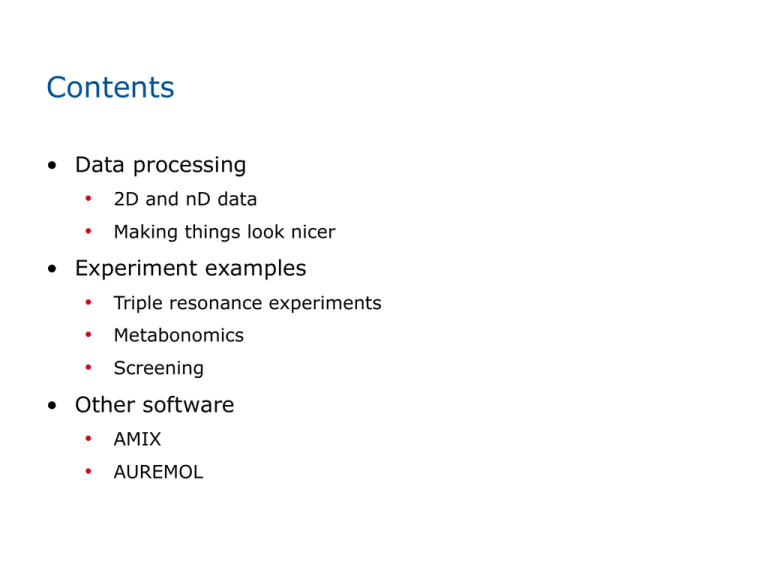
Contents • Data processing • 2D and nD data • Making things look nicer • Experiment examples • Triple resonance experiments • Metabonomics • Screening • Other software • AMIX • AUREMOL 2D processing Workflow: • Transform – xfb • Phase correct • Baseline – abs1, abs2, abs2.water • Set contours – levcalc • Peak pick – pp • Integrate – int2d Making it look nice • Improved spectra = improved peak picking • QFIL baseline correction in F1 to remove water stripe • WATERGATE to improve water suppression – wg in pulse sequence / parameter set name • Strip transforms to transform only part of the spectrum – particularly useful for 3D, and 15N HSQC • T1away! Nonlinear processing, so bad for integration, but may be useful for peakpicking Water “suppression” - QFIL • Parameter bc_mod controls baseline correction • NO= nothing • QUAD=dc offset correction • QPOL/QFIL = filter out zero frequency component • Need to also set bcfw • Use COROFFS if water not in the centre of the spectrum Cropping the spectrum – strip transform •Usually, centre of detected dimension is water frequency •Usually, detect amide protons – all have shift > 4.7 •Less points = faster data manipulation •Useful when viewing cubes/planes of cubes •Parameters: •STSR = first output point number, zero = left of spectrum •STSI = number of output points, SI/2 = left half •Note that points relate to SI , so to show only right half of dimension, set STSR to SI/2 and STSI to SI/2 More dimensions • As 2D, but: • Need to get phase parameters from 2D planes • Only real part of processed data kept (so phase in advance) • Strip transform more commonly used (reduced processed data size) • Note that processing takes time! • ftnd command handles up to 6D data, at least • Slices of nD data can be processed with xfb • Peak picking/integration still possible FTND • General FT of nD data • Options – ftnd a b c • a = dimensions to process and order, e.g. 31 processes f1 and f3, 0 = process all directions in default order • b = output procno • c = dlp – use delayed linear prediction • Example: ftnd 321 998 dlp • Transform f3, f2, and f1, store result in procno 998, use dlp. • DLP ensures no distortions arise from linear prediction • In Topspin 1.3, use ft3d for 3D data Extracting subsets • For nD data, one may want to view a subset, e.g. 2D plane from 3D cube • projcbp, projcbn, sumcb = positive, negative and sum cube projections • projplp, projpln, sumpl = positive, negative and sum planes • To extract single planes/cubes, use xfb/ft3d • Promts for plane/cube orientation and number Peak picking/integration • pp brings up appropriate dialogue box – any number of dimensions • Set thresholds using contour levels – remember to save! • Check and adjust manually! • Correlated windows useful • Can import peak list from another dataset for comparison • Can annotate peaks • int for integration Experiments – naming/information • Pulprog.info – describes Bruker naming system • NMR guide – pulse sequences, description, theory • 3D triple resonance manual (help->manuals) • Examples: • HNCAGP3D – both intra- and inter-residue HN->N->Ca correlation • HNCOCAGP3D – only inter-residue HN->N->Ca correlation • C_CANCO_3D – carbon-detected Ca->N->CO Pulprog.info •Lives in $topspinhome/exp/stan/nmr/lists/pp •Can see from edpul in 2.1 •Describes two-letter codes used for naming Bruker sequences 3D/triple resonance experiment families • Backbone assignment, e.g.: • • • • HNCO – inter-residue connection HNCA – both intra- (strong) and inter-residue (weaker) HN(CO)CA – only inter-residue HN(CA)CO – both • Backbone-sidechain, e.g.: • HN(CO)CACB – Ca / Cb have opposite phase • TOCSY experiments for whole sidechain • Coupling constant measurements – IPAP • NOESY type experiments Worked examples – HNCA/HN(CO)CA • HNCA shows intra- and inter-residue correlations • HN(CO)CA only shows inter-residue correlations •1JNCa = 11 Hz •2JNCa = 7 Hz •1JNCO = 15 Hz •2JNCO = <2 Hz Example: Hymenistatin • 8 residue cyclic peptide • Sequence: -Pro-Pro-Tyr-Val-Pro-Leu-Ile-Ile• No terminal residues, but prolines (no NH group) provide key to assignment • Few peaks, so can work with 2D planes of 3D experiments • H-Ca plane of HNCA and HNCOCA for backbone assignments • H-N plane for amide N Interpreting HNCA/HN(CO)CA pair Green = intra HN(n)->Ca(n) Black = inter HN(n)->Ca(n-1) Interpreting HNCA/HN(CO)CA pair Vertical correlation: HN(n)Ca(n) <-> HN(n)Ca(n-1) Horizontal correlation: HN(n)Ca(n) <-> HN(n+1)Ca(n) Interpreting HNCA/HN(CO)CA pair • Follow connections – vertical, then horizontal, then vertical – move to increasing residue number • Ca peak only in HNCA: • next residue is proline • next residue is N-methylated • current residue is terminus • (inter) Ca peak missing in HNCA = preceding residue is proline • No peaks seen for a proline residue preceding another proline -Pro-Pro-Tyr-Val-Pro-Leu-Ile-IleInterpreting HNCA/HN(CO)CA pair Interpreting HNCA/HN(CO)CA pair Other aspects of biological NMR • Bio-NMR is not just 3D triple resonance! • Screening experiments to observe ligand binding • SAR by NMR (15N HSQC) • Saturation transfer difference • WATER-LOGSY • Metabonomics • Study of relationships between metabolites and diseases etc. • Can be combined with LC/MS Screening - STD • Saturation transfer difference (STD) – identify ligands which bind to your protein • Does not require much protein (has been done on 1 nmolar!) • Observe ligand signals – large excess of ligand useful • No labelling required • Can observe competition between ligands • Some information about binding site on ligand • Suitable for large proteins (ideally >20kDa) STD – how it works 1. Selective irradiation of a well separated protein signal 2. Spin diffusion quickly spreads the saturation to all protein-protons 3. Intermolecular NOE transfers saturation to ligand-protons at the binding site 4. Exchange between bound (saturated) and free ligands allows further ligand saturation if ligand in excess 1. selective irradiation H H H H H 2. spin H diffusion protein H H H H H H H H ligand H H H H 3. intermolecular NOE H H H H H H H H H H Patent: Bernt Meyer, University of Hamburg, Germany Ref: Mayer & Meyer JACS 123 (2001) 6108-6117 Review: Angew. Chem. Int. Ed., 42 (2003, ) 864-890 STD - results • Screening: identification of the binding component(s) from a mixture through positive NOE signals • Epitope mapping: parts of the ligand in contact with the protein give strongest response • Competition: add a known binder, response from candidate reduced if it binds at correct site STD - implementation • Parameter sets e.g. STDIFFESGP • Frequency list: protein on-res (e.g. <0 ppm – away from ligand) and off-res (e.g. –20ppm) • Can include CPMG (t2) filter to remove broad protein signals (e.g. stdiffesgp.3) • Standard bruker sequences make pseudo 2D • Need to take the difference afterwards • Sequence available with automatic subtraction (i.e. output spectrum is difference) on request Metabonomics • Statistical analysis of metabolite solutions, e.g. urine, plasma • Need good quality data! • Parameter sets available in TS2 which take full advantage of hardware/software improvements • Take care of temperature regulation/shimming • Water suppression – noesygppr1d • Good suppression, integratable spectra • Not a NOESY! Mixing time short, d8=10msec Metabonomics parameter sets • MET_NOEGPPR1D – noesy presat • MET_DIFFUFILT – diffusion filtered (remove smaller molecules) • MET_CPMGPR1D – CPMG t2 fiter (remove protein signals) • MET_COSYGPPR – COSY, with presat • Parameter sets use improved digital filters • Noesygppr1d spectra – use akp0.noe for phasing Example – water suppression AUREMOL AMIX – mixture analysis/statistics
